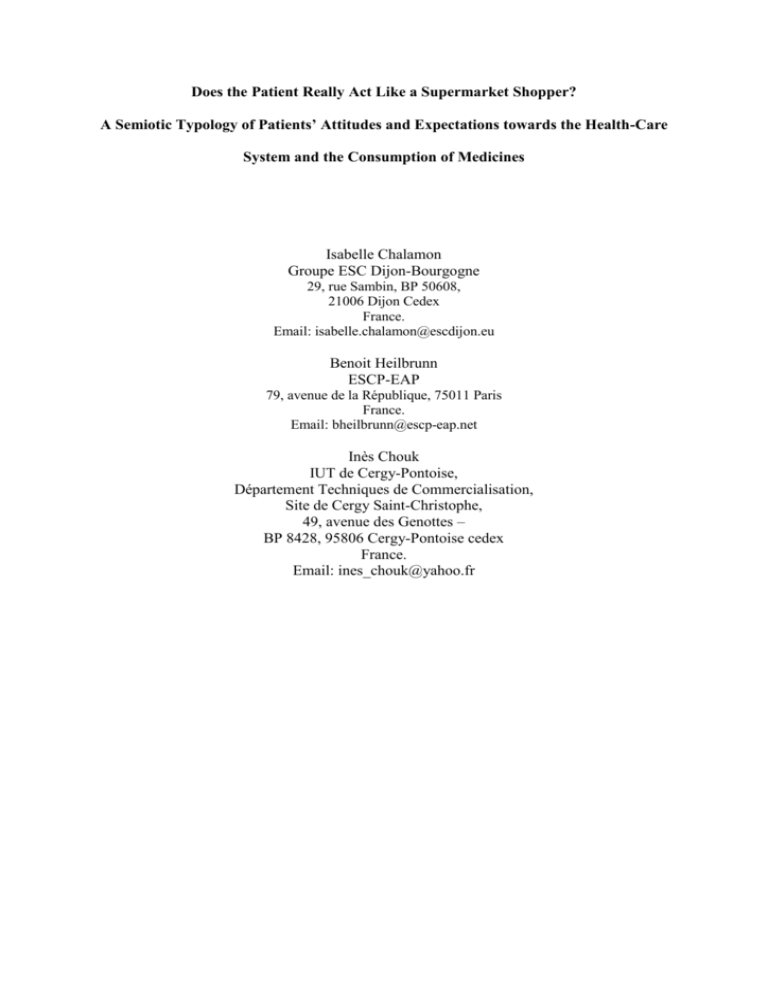Proposal of a Typology of Patients` Attitudes and Expectations
advertisement

Does the Patient Really Act Like a Supermarket Shopper? A Semiotic Typology of Patients’ Attitudes and Expectations towards the Health-Care System and the Consumption of Medicines Isabelle Chalamon Groupe ESC Dijon-Bourgogne 29, rue Sambin, BP 50608, 21006 Dijon Cedex France. Email: isabelle.chalamon@escdijon.eu Benoit Heilbrunn ESCP-EAP 79, avenue de la République, 75011 Paris France. Email: bheilbrunn@escp-eap.net Inès Chouk IUT de Cergy-Pontoise, Département Techniques de Commercialisation, Site de Cergy Saint-Christophe, 49, avenue des Genottes – BP 8428, 95806 Cergy-Pontoise cedex France. Email: ines_chouk@yahoo.fr Does the Patient Really Act Like a Supermarket Shopper? A Semiotic Typology of Patients’ Attitudes and Expectations towards the Health-Care System and the Consumption of Medicines Abstract The purpose of this paper is to propose a general typology of patients’ attitudes and expectations towards the health-care system and medicines consumption. Four types of values expressed by patients are identified via a semiotic analysis of patients’ expectations. These value types are labelled functional, existential, critical, and hedonistic. Based on these values we then empirically identify four patient profiles. From a managerial point of view, this research provides a segmentation tool relevant for the health-care sector and enables managers in the health-care industry to identify communication strategies which are adapted to the different types of patients. What do patients expect of the health-care system? How can we explain the diversity of these expectations and how can we classify them? The purpose of this paper is to answer these questions by proposing a general typology of patients’ attitudes and expectations towards the health-care system and medicines consumption. In the health-care sector, the patient occupies a more and more central place. Increasingly active in health-care decision making (Shaffer and Sherrell 1995; Charles, Gafni, and Whelan 1999; Stevenson, Barry, Britten, Barber, and Bradley 2000), the patient is often treated as a "participant actor", as a "patient-expert" (Barbot 2002; Fox, Ward, and O’Rourke 1999), or as a "consumer" of medicine and health-care. He (or she)’s involved in his/her own diagnosis and treatment, (Herzlich and Pierret 1984) and is actively in search of information (Risker 1996; Wagner, Hu, and Hibbard 2001). The patient, as a final user of the health care system, is thus emerging as an increasingly pivotal research object. The existing literature presents many typologies such as patients’ preferences for various attributes of the doctor-patient relationship (Vick and Scott 1998), patients’ participation in healthcare decision-making (Flynn, Smith, and Vanness 2006), patient’s behaviours in healthcare services (Shaffer and Sherrell 1995) and of patients’ satisfaction (Singh 1990). Two main limits of these approaches can be identified. Firstly, these typologies focuse only on one dimension of the relationship between patients and the health-care system. A more global approach is required in order to really understand patients’ preferences and expectations with respect to the health-care system and medicines consumption. Secondly, these typologies are based on "fixed" positions: each patient of the sample is "classified" in one cluster. But the points of view expressed are largely dependant on situational variables. We need to identify "virtual positions" and, based on theses positions, built situational "scenarios". In this context, our research objective is to develop a general conceptual framework to understand and classify patients’ expectations towards the health-care system and medicines consumption. Furthermore, from a managerial point of view, there is no clear market "segmentation" of patients behaviours in this sector. Thus, the aim of our research, is to propose a relevant "segmentation tool" in the health-care context. It will provide professionals in this sector with a global vision of the final consumer’s expectations. Based on this segmentation, improvements in service quality and patients’ global satisfaction could be made. Indeed, the proposed classification will help doctors and institutional organizations to better understand patients’ expectations and hence to meet their preferences more accurately. Moreover, based on this typology, pharmaceutical firms and actors in the field of health-care could provide a better positioning of their offers and develop more adapted communication strategies. In order to develop a typology based on virtual positions, we carried out a semiotic analysis (Greimas 1983; Greimas and Courtès 1983) of patient's representations and expectations of the health-care system and medicines consumption, on the base of 38 semi-structured interviews. Four types of values expressed by patients were identified: the functional, the existential, the critical and the hedonistic values. The "functional" patient has a problem/solution logic and a functional approach towards health-care. On the other hand, the "existential patient" values health-care in a more global way: his definition of good health is more than just "not to be ill". This kind of patient trusts the system greatly and has a social approach to medicine: he feels that dialogue is a part of treatment and his choice may be influenced by peers or professional advice. The "critical patient" has a consumerist approach towards medicine. He is in a logic of comparison and budget-optimisation. Hedonistic valorisation is the negation of practical values. For this type of patient, health-care is a kind of "game" in which only the ludical dimension of the service is considered. Based on these values, a quantitative study was carried out in order to identify a typology of patients: data were collected on 200 patients. We identified four patient profiles: Hedonist, Functional, Optimizer, and Skeptic. This study has two main contributions. First, this research underlines the interest of a structural semiotic approach to study the behaviour of health-care consumers. This approach provides an analytic tool to understand the variety of patients’ attitudes and behaviours regarding health, health-care and medicines consumption. From a theoretical point of view, we can conclude that patients may be studied as consumers, and that medicine and health-care services are evaluated and valorised in the same way as other products or services. Second, this study provides a segmentation of patient behaviours. Based on patients’ values, a typology of four patient profiles was proposed: hedonists, functionals, skeptics and optimizers. Based on the real-world heterogeneity of health-care consumers, our analysis should permit the development of a more targeted approach for each patient-type, and indeed a more global, uniform, yet accurately partitioned communication strategy. Depending on the cluster characteristics, different communication strategies should be adopted. For example, for skeptics, communication should be concentrated on the benevolence of the pharmacist/doctor. Optimizers, on the contrary, are more interested in cheaper products. Functionals are sensitive to the promptness of service, and hedonists to the benefits of the products on their welfare. Given the specificity of the context (France) and the size of our sample, additional research should be realized to determine the extent to which the results can be generalized. References Barbot, Janine (2002), Les Malades en Mouvement, la Médecine et la Science à l’Epreuve du Sida, Paris, Balland. Charles, Cathy, Amiram Gafni, and Tim Whelan (1999), "Decision-Making in the PhysicianPatient Encounter: Revisiting the Shared Treatment Decision-Making Model", Social Science and Medicine, 49, 651-61. Flynn, Kathryn E., Maureen A. Smith, and David Vanness (2006), "A Typology of Preferences for Participation in Healthcare Decision Making", Social Science and Medicine, 63, 1158-69. Floch, Jean Marie (1988), "The Contribution of Structural Semiotics to the Design of a Hypermarket", International Journal of Research in Marketing, 4, 3, 233-53. ____ (2001), Semiotics, Marketing and Communication: Beneath the Signs, the Strategies, Palgrave Macmillan. Fox, Nicholas J., Katie J. Ward, and Alan J. O’Rourke (1999), "The ‘expert patient’: empowerment or medical dominance? The case of Weight loss, pharmaceutical drugs and the Internet", Social Science and Medicine, 60, 1299-309. Greimas Algirdas J. (1983), Structural Semantics: An Attempt at a Method, Lincoln, University of Nebraska Press. Greimas, Algirdas J. and Joseph Courtès (1983), Semiotics and language: an Analytical Dictionary, Indiana University Press. Herzlich, Claudine and Janine Pierret (1984), Malades d’Hier, Malades d’Aujourd’hui. De la Mort Collective au Devoir de Guérison, Paris, Payot. Risker, Christopher D. (1996), "The Health Belief Model and Consumer Information Searches: towards an integrated Model", Health Marketing Quarterly, 13, 3, 13-26. Singh, Jagdip (1990), "A Multifacet Typology of Patient Satisfaction with Hospital Stay", Journal of Health-care Marketing, 10, 4, 8-20. Shaffer, Teri R. and Daniel L. Sherrell (1995), "Exploring Patient Role Behaviors for Healthcare Services: The Assertive, Activated and Passive Patient", Health Marketing Quarterly, 13, 1, 19-35. Stevenson, Fiona A., Christine A. Barry, Nicky Britten, Nick Barber, and Colin P. Bradley (2000), "Doctor-patient communication about drugs: the evidence for shared decision making", Social Science and Medicine, 50, 829-40. Vick, Sandra and Anthony Scott (1998), "Agency in Health-care. Examining Patients’ Preferences for Attributes of the Doctor-Patient Relationship", Journal of Health Economics, 17, 587-605. Wagner, Todd H., Teh- wei Hu, and Judith H. Hibbard (2001), "The Demand for Consumer Health Information" Journal of Health Economics, 20, 1059-75. Zandbelt, Linda C., Ellen M. A. Smets, Frans J. Oort, and Hanneke C. J. M. De Haes (2005), "Coding Patient-Centred Behaviour in the Medical Encounter, Social Science and Medicine, 61, 661-71.










